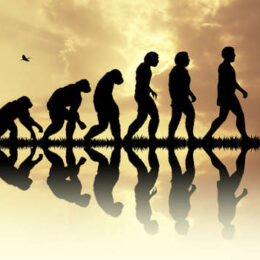THE SPECTRUM of HUMAN EVOLUTION
Let’s start things off with a riddle:
The beginning of evolution
Is the end of time and space
The beginning of every end
Is the end to every place
Can you guess the riddle?
Hi, everyone. This is my first weekly post which takes a look the evolution of our species past, present and future. My next post will cover the history of social/cultural evolution and how it has exacerbated the political divide in this country and how we can attempt a fix.
Future posts will explore various topics that are relevant to human advancement as well as our survival on this planet. Topics will be seen through the lens of physical/mental and cultural evolution. The physical/mental, which is explored in this post, considers human evolution through the genetic component and how evolution is being impacted by the human constructs of curiosity, imagination and creativity. Cultural evolution will be examined as it now exists through the evolution of civilization and how it has impacted human relationships and interactions between family and society.
The past four years are a prime example of how civil interruptions can be detrimental to human culture and society’s progress. But on the flip side, one has to question, what is considered progressive evolution and is it always for good or can progress also be evil?
As D.T. Max asked in his April of 2017 National Geographic article “Beyond Human:”
“Are we on the way to redefining how we evolve? Does evolution now mean not just the slow grind of natural selection spreading desirable genes, but also everything that we can do to amplify our powers and the powers of the things we make – a union of genes, culture, and technology?
And if so, where is it taking us?
First the Past
Evolution on planet Earth has never stopped – it is relentless. When the chances of any living thing’s survival can be increased, nature will find ways to mutate to make it happen.
Primates diverged from other mammals about 85 million years ago. A major climate shift happened between 3.0 and 2.5 million years ago marking the onset of Northern Hemisphere glacial period. This period generally coincides with the timing of the origin of the genus Homo which leads us to, Homo Sapien.
The oldest known skeleton of a modern human dates to about 200,000 years ago. Modern humans evolved beginning with primates which lead to the emergence of Homo Sapiens as a distinct species. This process involved the gradual development of traits such as upright walking and language. Modern human language is thought to have begun about 100 thousand years ago and we haven’t shut up since. Humans are thought to have migrated out of Africa about 60 thousand years ago, about 20 thousand years before the Neanderthal species died out. The question of whether the Neanderthal was killed-off or interbred with Homo Sapiens is still a matter of debate. Because modern humans have a small amount of Neanderthal DNA it supports the interbreeding theory. Plus, our Neanderthal relatives can be seen on any given Sunday playing football as NFL lineman.
It was thought that human evolution took millions of years but over the past 3,000 years, many populations have evolved genetic adaptations to their local environments. As humans migrated north their skin lighten to allow the absorption of Vitamin D in the shorter daylight environment. People in Siberia and the high arctic have developed metabolisms that are uniquely adapted to survive extreme cold; the Bajau people of the South Pacific can dive 70 meters and stay underwater for almost 15 minutes because of unusually large, oxygen holding spleens like deep diving seals; people that live in the Hymnals have evolve to flourish in a lower oxygen environment. Three thousand years sounds like a long time but it’s the fastest known adaptation ever to have evolved in humans.
Now the Future
Biological evolution may be unstoppable and more skillful than the genetic evolution humans can initiate with crossbreeding in plants and animals, but how important is it, measured against the adaptations we can devise with our amazing brains? As the futurist Ray Kurzweil said, “We will transcend all of the limitations of our biology. That is what it means to be human – to extend who we are.”
It’s clear that human evolution isn’t over. Surviving to reproductive age is what drives natural selection, the force behind evolutionary change. The big question is, will our technological and scientific innovations impact our evolution?
Modern medicine has allowed longer survival which becomes encoded as part of evolution. Good sanitation, antibiotics and vaccines all make differences between genes less important and modern medical procedures that prevent death all tend to stop natural selection through genes, allowing survival to a reproductive age. Modern medicine also allows genetic drift which makes genetic differences vary randomly within a population because harmful mutations don’t kill people and thus are not eliminated. These modifications are not to genes themselves but to when and how those genes are expressed, the science of which is called Epigenetics. These changes can happen in as short a time frame as one lifetime and be passed on to offspring. For example, human drug addiction has been shown to be pasted to offspring through the sperm and egg in a single generation.
Technology now does much of the same work and does it far faster, bolstering our physical skills, deepening our intellectual range, and allowing us to expand into new and more challenging environments.
A prime example is the new technology called CRISPR-Cas9 which is a procedure to snip out a section of DNA sequence from a gene and put a different one in, quickly and accurately. What used to take researchers years now takes a fraction of the time. No technology has remotely existed before that is as powerful for the manipulation of the human genome. Designing synthetic cells beyond the bounds of evolution (so called “Designer Cells”) is encompassing everything from reengineering pig embryos to make their organs safer for human transplant to trying to fix the genetic defect in human embryos. The moral implications of playing God or creating a Hitler type super-race have to be weighed against the ability to correct natures mistakes by producing disease-free embryos. At this time there is an international moratorium on all therapies for making heritable changes in human genes until they are proved safe and effective. CRISPR is no exception.
Most scientist don’t think the ban will last. Some pointed to the history of in-vitro fertilization (IVF) as a precedent. It was first touted as a medical procedure for otherwise infertile couples. Soon its potential to eradicate devastating genetic diseases was clear. Evolution is not benign and much human suffering has come from nature’s mistakes. As IVF became more familiar, its accepted purpose spread from preventing disease to include the designer cells of sex selection and even choosing desired hair and eye color.
CRISPR is a vastly more powerful technology than IVF, with a far greater risk of abuse. But the moral issues aside, the potential benefits of applying CRISPR to humans are undeniable and many feel that as soon as CRISPR is shown to be safe, ethical questions will recede, just as they did with IVF. There are already 2,300 CRISPR gene therapy trials under way, including for anti-aging and Alzheimer’s disease.
As George Church, a molecular engineer at Harvard and MIT stated, “DNA was left in the dust by cultural evolution. But now it’s catching up.”
Riddle Answer:
The letter E
Read More



